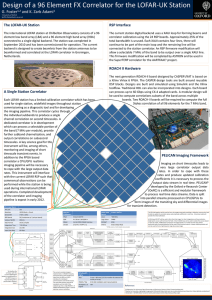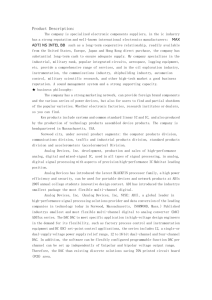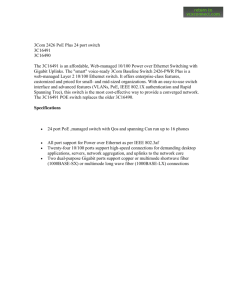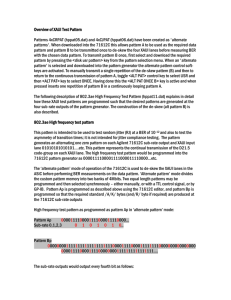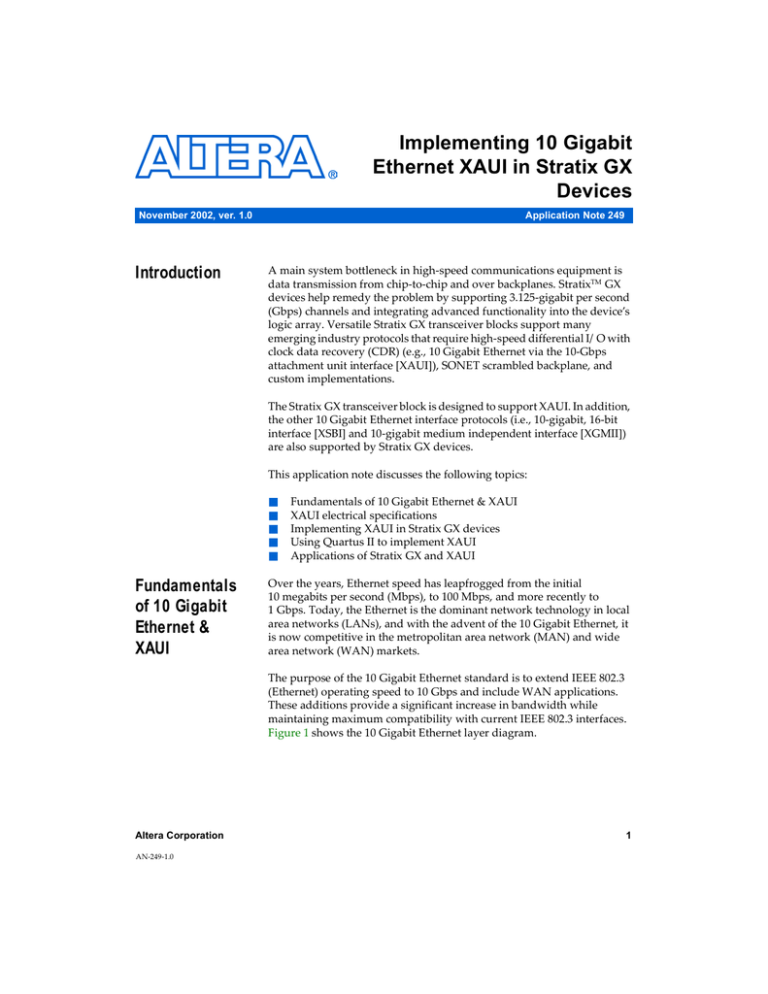
Implementing 10 Gigabit
Ethernet XAUI in Stratix GX
Devices
November 2002, ver. 1.0
Introduction
Application Note 249
A main system bottleneck in high-speed communications equipment is
data transmission from chip-to-chip and over backplanes. StratixTM GX
devices help remedy the problem by supporting 3.125-gigabit per second
(Gbps) channels and integrating advanced functionality into the device’s
logic array. Versatile Stratix GX transceiver blocks support many
emerging industry protocols that require high-speed differential I/O with
clock data recovery (CDR) (e.g., 10 Gigabit Ethernet via the 10-Gbps
attachment unit interface [XAUI]), SONET scrambled backplane, and
custom implementations.
The Stratix GX transceiver block is designed to support XAUI. In addition,
the other 10 Gigabit Ethernet interface protocols (i.e., 10-gigabit, 16-bit
interface [XSBI] and 10-gigabit medium independent interface [XGMII])
are also supported by Stratix GX devices.
This application note discusses the following topics:
■
■
■
■
■
Fundamentals
of 10 Gigabit
Ethernet &
XAUI
Fundamentals of 10 Gigabit Ethernet & XAUI
XAUI electrical specifications
Implementing XAUI in Stratix GX devices
Using Quartus II to implement XAUI
Applications of Stratix GX and XAUI
Over the years, Ethernet speed has leapfrogged from the initial
10 megabits per second (Mbps), to 100 Mbps, and more recently to
1 Gbps. Today, the Ethernet is the dominant network technology in local
area networks (LANs), and with the advent of the 10 Gigabit Ethernet, it
is now competitive in the metropolitan area network (MAN) and wide
area network (WAN) markets.
The purpose of the 10 Gigabit Ethernet standard is to extend IEEE 802.3
(Ethernet) operating speed to 10 Gbps and include WAN applications.
These additions provide a significant increase in bandwidth while
maintaining maximum compatibility with current IEEE 802.3 interfaces.
Figure 1 shows the 10 Gigabit Ethernet layer diagram.
Altera Corporation
AN-249-1.0
1
AN 249: Implementing 10 Gigabit Ethernet XAUI in Stratix GX Devices
Figure 1. 10 Gigabit Ethernet Layer Diagram
Upper Layers
MAC Control (Optional)
Media Access Controller (MAC)
Reconciliation
XGMII: 10-Gigabit Medium Independent Interface
XGXS: XAUI Extender Sublayer
XAUI: 10-Gigabit Attachment Unit Interface
XSBI: 10-Gigabit 16-bit Interface
MDI: Medium Dependent Interface
XGMII
XGXS (1)
XAUI
XGXS (1)
XGMII/XAUI
64b/66b Coding
XGMII
Physical Coding Sublayer (PCS)
WAN-Compatible Framing
WAN Interface Sublayer (WIS) (1), (2)
16-Bit Parallel (OIF) (3)
XSBI
Physical Medium Attachment (PMA)
Physical Medium Dependent (PMD)
Retime, SERDES (4), CDR
E/O
MDI
Medium
Notes to Figure 1:
(1)
(2)
(3)
(4)
Optional sublayer.
Adding the WIS makes the WAN a PHY layer.
OIF: Optical Interworking Forum.
SERDES: serializer/deserializer.
The Ethernet PHY layer—(i.e., layer 1 of the open systems interconnection
[OSI] model)—connects the media (e.g., optical or copper) to the MAC
layer (i.e., layer 2). The Ethernet architecture further divides the PHY layer
into a PMD sublayer, a PMA sublayer, and a PCS. For example, optical
transceivers are PMD sublayers. The PMA converts the data between the
PMD sublayer and the PCS. The PCS is made up of coding (e.g., 8b/10b,
64b/66b) and serializer, or multiplexing functions.
Altera Corporation
2
AN 249: Implementing 10 Gigabit Ethernet XAUI in Stratix GX Devices
The 10 Gigabit Ethernet has three different implementations for the PHY
layer:
■
■
■
10GBASE-X
10GBASE-R
10GBASE-W
The 10GBASE-X implementation is a PHY layer that supports XAUI.
XAUI, used in conjunction with the XGMII extender sublayer (XGXS),
allows more separation in distance between the MAC and PHY layers.
The 10GBASE-X PCS uses four lanes of 8b/10b coded data at a rate of
3.125 Gbps. The 10GBASE-X is a wide wave division multiplexing
(WWDM) LAN PHY layer.
The 10GBASE-R and 10GBASE-W are serial LAN PHY layers and serial
WAN PHY layers, respectively. Unlike the 10GBASE-X implementation,
the 10GBASE-R and 10GBASE-W implementations have an XSBI
interface.
XAUI Fundamentals
XAUI is designed as an interface extender for the 10 Gigabit XGMII. You
can use XAUI in various applications including 10 Gigabit Ethernet line
cards, LAN-to-WAN bridges (i.e., Ethernet to SONET converter), and as a
backplane and chip-to-chip interconnect.
Using 1.5-V PCML electrical levels, XAUI uses four full-duplex serial links
at 3.125 Gbps in each direction. In aggregate, you can transfer a total of
12.5 Gbps in each direction using the XAUI standard. The 8b/10b
encoding/decoding overhead supports a 10-Gbps throughput. At those
rates, the protocol can also accommodate SONET OC-192 traffic.
Figure 2 shows that Stratix GX devices are designed for easy XAUI
implementation. You can implement higher-level layers in the
programmable logic section of Stratix GX devices, including
reconciliation, MAC, switching functions, and a protocol bridge. In
addition, the Stratix GX gigabit transceiver block contains the required
components for implementing the XAUI physical layer (see Figure 2). The
XAUI physical layer, also known as the XGXS, contains the XAUI
sublayers PCS, PMA, and PMD.
Altera Corporation
3
AN 249: Implementing 10 Gigabit Ethernet XAUI in Stratix GX Devices
Figure 2. Implementing XAUI in Stratix GX Devices
Data[31..0] CTRL Clk
XGMII
Linecard
Rate
Matching
FIFO
Protocol Bridge
MAC
Switching
Functions
XAUI Physical Layer
XAUI
Meshed
Backplane
XAUI Physical Layer
Reconciliation
Channel
Alignment
Reconciliation
XGMII
XGMII
Stratix GX
Logic Array
8B/10B
Decoder
Stratix GX
Transceiver
XAUI Receiver
PHY Layer
Stratix GX
Transceiver
Comma
Detector
Switching
Functions
MAC
Protocol Bridge
Symbol
Aligner
Stratix GX
Logic Array
SERDES
Clock
Recovery
Unit
Linecard
XAUI
Data[3..0] Ref Clk
f
XAUI Electrical
Specification
For more information on 10 Gigabit Ethernet and the XAUI, visit the
10 Gigabit Ethernet Alliance web site at www.10gea.org.
The XAUI electrical characteristics, a XGMII (10-gigabit media
independent interface) extender, are described in this section according to
the IEEE P802.3ae standard, clause 47 of the IEEE Draft P802.3ae/D4.1
document. Specifically, this section describes XAUI:
■
■
■
■
■
■
■
■
■
■
Altera Corporation
Signal levels
Signal path
Driver characteristics
Load impedance
Amplitude & swing
Driver template & jitter
Receiver characteristics
Skew/jitter budget
Characteristic impedance
Stratix GX support of the XAUI standard
4
AN 249: Implementing 10 Gigabit Ethernet XAUI in Stratix GX Devices
Signal Levels
To allow maximum interoperability between different supply-voltage
components, XAUI uses a low swing, AC-coupled differential interface.
The low swing differential interface signals minimize noise and
electromagnetic interference (EMI).
Signal Path
XAUI signal paths are point-to-point connections. XAUI has four lanes,
and each lane corresponds to one pair of transmit and one pair of receive
differential traces. The signal paths are intended to operate across 50 cm
with controlled impedance traces in FR-4 material. Stratix GX devices
support one meter (40”) of FR-4 trace and two connectors.
Driver Characteristics
The XAUI data rate is specified to be 3.125 Gbps ±100 PPM. The nominal
unit interval is 320 ps. Table 1 summarizes the XAUI driver
characteristics.
Table 1. XAUI Driver Characteristics
Value
Unit
Data rate tolerance
Parameter
3.125 Gbps ± 100 PPM
Gbps PPM
Unit interval nominal
320
ps
Differential amplitude maximum
1,600
mVp-p
Absolute output voltage limit (maximum)
2.3
V
Absolute output voltage limit (minimum)
−0.4
V
Output jitter near-end maximums
(total jitter) (1)
±0.175 from the mean
UI p-p
Output jitter near-end maximums
(deterministic jitter) (1)
±0.085 from the mean
UI p-p
Output jitter far-end maximums
(total jitter) (2)
±0.275 from the mean
UI p-p
Output jitter far-end maximums
(deterministic jitter) (2)
±0.185 from the mean
UI p-p
Notes to Table 1:
(1)
(2)
Altera Corporation
Near-end is the transmitter side.
Far-end is the receiver side.
5
AN 249: Implementing 10 Gigabit Ethernet XAUI in Stratix GX Devices
Load Impedance
The load is 100 Ω ± 5% differential. Stratix GX devices support
programmable on-chip differential termination of 100 Ω, 120 Ω, and 150 Ω.
Amplitude & Swing
The maximum differential output amplitude is specified to be 1,600 mVp-p
including any transmit equalization. The receiver is AC-coupled. The
absolute output voltage of the driver should be between −0.4 V and 2.3 V
with respect to ground.
Driver Template & Jitter
Table 2 shows the driver template intervals. The driver should comply
with either near-end, or far-end, eye template and jitter requirements.
Jitter for a data signal is usually measured in terms of unit intervals (UIs).
Figure 3 shows the driver template.
Figure 3. Driver Template
A2
A1
0
-A1
-A2
0
Altera Corporation
X1
X2
1 - X2
1 - X1
1
6
AN 249: Implementing 10 Gigabit Ethernet XAUI in Stratix GX Devices
The maximum total jitter ±0.175 UIp-p from the mean is required at the
near-end. The maximum deterministic component is ± 0.085 UIp-p. The
maximum total jitter is 0.275 UIp-p from the mean at the far-end and
maximum deterministic component is 0.185 UIp-p from the mean.
Table 2. Driver Template Intervals
Symbol
Near-End Value Far-End Value
Unit
X1
0.175
0.275
X2
0.390
0.400
UI
UI
A1
400
100
mV
A2
800
800
mV
Receiver Characteristics
The peak-to-peak total jitter amplitude tolerance for the XAUI receiver
should be at least 0.65 UIp-p. The total jitter consists of three components:
deterministic, random, and an additional sinusoidal jitter. Table 3 shows
the receiver characteristics.
Table 3. Receiver Characteristics
Parameter
Value
Units
Data rate
3.125
Gbps
Tolerance
±100
PPM
UI nominal
320
ps
Receiver coupling
AC
Jitter amplitude tolerance
0.65
UIp-p
Skew/Jitter Budget
The peak-to-peak total jitter tolerance for the XAUI receiver must be at
least 0.65 UI. There are three components in the total jitter tolerance:
deterministic jitter, random jitter, and sinusoidal jitter. As described in the
IEEE P802.3ae standard, the deterministic jitter tolerance must be at least
0.37 UIp-p. The sum of the deterministic and random jitter tolerance is
0.55 UIp-p. Figure 4 shows a single-tone sinusoidal jitter tolerance with
any frequency and amplitude.
Altera Corporation
7
AN 249: Implementing 10 Gigabit Ethernet XAUI in Stratix GX Devices
Figure 4. Single-Tone Sinusoidal Jitter Mask
Sinusoidal Jitter
Amplitude
8.5 UIp-p
0.1UIp-p
Frequency
22.1 kHz
1.875 MHz
20 MHz
Characteristic Impedance
The recommended differential characteristic impedance of circuit board
trace pairs is100 %
Altera Corporation
8
AN 249: Implementing 10 Gigabit Ethernet XAUI in Stratix GX Devices
Stratix GX Support of the XAUI Standard
Stratix GX devices are ideal for the XAUI standard. Table 4 summarizes
Stratix GX device support for XAUI.
Table 4. Stratix GX Support for XAUI
Parameter
XAUI
Stratix GX
Support
Unit
Data rate
3.125
0.622 to 3.125
Gbps
Tolerance
±100
±100
PPM
Driver differential amplitude maximum
1,600
1600
mVp-p
320
Yes
ps
Absolute output voltage limit (maximum)
2.3
Yes
V
Absolute output voltage limit (minimum)
−0.4
Yes
V
50 cm (~20”)
100 cm (~40”)
cm
Receiver coupling
AC-Coupled
Yes
Receiver jitter tolerance
At least 0.65
Yes
UI
UI
Unit interval nominal
Drive capabilities
Receiver deterministic jitter tolerance
Receiver bit error ratio
Receiver input amplitude tolerance
Implementing
XAUI in
Stratix GX
Devices
At least 0.37
Yes
Less than 10-12
10-12
May be larger than 1,600
1,600
mVp-p
Figure 5 shows the Stratix GX gigabit transceiver block, made up of four
channels (the term channel and lanes are interchangeable in the XAUI
standard) and the supporting logic. Each channel contains a receiver and
transmitter. The supporting logic contains a phase-locked loop (PLL),
which generates clocks for the four channels’ CDR reference.
The XAUI channel alignment state machine is included in the transceiver
block’s supporting logic and interacts with the XAUI channel alignment
logic in the receiver.
■
■
Altera Corporation
The XAUI mode receiver operates with J = 10, a full automatic
synchronizer and word aligner, a channel aligner and first-in first-out
(FIFO) buffer, and a rate-matching FIFO followed by the 8b/10b
decoder.
The XAUI mode transmitter operates with J = 10, a transmit FIFO
followed by the 8b/10b encoder. All of the components of the
transceiver are used to implement XAUI.
9
AN 249: Implementing 10 Gigabit Ethernet XAUI in Stratix GX Devices
Figure 5. Architectural Overview of the Stratix GX Transceiver Block
RX0
Channel 0
TX0
RX1
Channel 1
TX1
Logic Array
Supporting Logic
REFCLK
RX2
Channel 2
TX2
RX2
Channel 3
TX2
Transceiver Block
Stratix GX Device at the Receiver Side of XAUI
Figure 6 shows a Stratix GX device at the XAUI receiver side, where
3.125 Gbps of serial data is deserialized into 10-bit parallel data. The
pattern detector detects comma patterns (i.e., either K28.1, K28.7, or K28.5)
from the parallel data, and the word aligner aligns the data based on the
incoming K set. Because the data is going through four separate channels,
it is likely that the channels are skewed with respect to each other. To solve
this potential problem, the decoded data is processed by the rate matching
block and then by the channel alignment block. The aligned data is then
fed into the 8b/10b decoder.
Altera Corporation
10
AN 249: Implementing 10 Gigabit Ethernet XAUI in Stratix GX Devices
Figure 6. Stratix GX Device at the XAUI Receiver Side
Synchronizer
Serial-to-Parallel
Clock
Recovery
Unit
Reference
Clock
Pattern
Detector
& Word
Alligner
Recovered
Clock to Core
Channel
Aligner
& Rate
Matcher
8b/10b
Decoder
RxPLL
The following section describes the duties of each module (shown in
Figure 6) as the data is processed and transmitted to one of the Stratix GX
device’s receiver channels.
Clock Recovery Unit (CRU)
The CRU block is the unit that takes the serial data input at the receiver
and generates a clock based on the data transitions. The CRU block is
mostly an analog block and should be simulated simply as a clock
generator that locks to the data-in rate. You cannot bypass the CRU block.
Deserializer
The deserializer is a serial-to-parallel data converter. It accepts serial data
input clocked at a certain rate and generates parallel data (i.e., J bits wide,
where J is programmable) at 1/J the serial rate. J is called the
deserialization factor. XAUI uses the deserialization factor of 10 (J = 10)
parallel. You cannot bypass the deserializer block.
Pattern Detector
Data enters the pattern detector after leaving the deserializer. The pattern
detector searches for a comma pattern across the entire incoming data that
is word-aligned. The pattern detector checks for a pattern in every bit
position, and is used to identify predetermined bit patterns in the
transceiver. To ensure pattern recognition, a /K28.5/ pattern (i.e.,
0011111010) is pre-programmed (via the Quartus® II software) into the
pattern detector.
Altera Corporation
11
AN 249: Implementing 10 Gigabit Ethernet XAUI in Stratix GX Devices
Word Aligner
The main function of the word aligner is to synchronize the word clock to
the data stream word boundary by detecting and aligning a specific
programmable pattern known as the COMMA character. In XAUI mode,
a built-in synchronization state machine monitors word alignment.
The purpose of the synchronization state machine is to determine if the
receiver is ready for the operation. The state machine informs the upper
layer that the link is ready. If there is no signal, or a disparity error, or a
word alignment error, the state machine tells the upper layer that the link
is down. Figure 7 shows the block diagram of the synchronization state
machine.
Figure 7. Block Diagram of the Synchronization State Machine
enable_cdet
sync_status
comma
invalid_code
SYNC_SM
kchar
data_in
bitslip
sync_status_deskew
COMMA_DETECT
sync_status
invalid_code
disper and pre
pattern_detect
aligned_data
dataout_pre
clk
ena_cdet
The synchronization state machine supports the XAUI protocol. In XAUI
mode, the sync_status signal goes high upon detection of a /K/
pattern four times. You can follow each comma by any number of valid
code-groups.
When receiving, each channel decodes its received 10b receiver codegroup to its 8b code-group and control signals. When the decoder detects
an invalid code, it generates an internal invalid code signal that can be
used by the internal state machines.
Altera Corporation
12
AN 249: Implementing 10 Gigabit Ethernet XAUI in Stratix GX Devices
Channel Aligner
The purpose of the channel aligner is to align the data for all channels (i.e.,
synchronize the channels) to the same recovered clock. The channel
aligner is only active when the transceiver block is in XAUI mode, and it
consists of a channel alignment symbol detector and a channel aligner
FIFO buffer. The system relies on the common channel aligner state
machine in the transceiver’s common block. Each receiver has its own
CDR block and the data arrives at each receiver pin at slightly different
times. The channel aligner synchronizes the data from the FIFO buffer to
the clock edge of channel 0’s recovered clock; thus, assuring that the data
from the four receiver channels is aligned correctly before the data is sent
to the next layer. See Figure 8.
Figure 8. Channel Aligner State Machine
Recovered Clock (from channel0 of the receiver)
synch_status_deskew
align_status
sync_status[3..0] from word aligners
fifo_reset_rd
adet[3..0]
enable_deskew
Deskew_SM
word_align
(channel0)
deskew_fifo
(channel0)
word_align
(channel1)
deskew_fifo
(channel1)
word_align
(channel2)
deskew_fifo
(channel2)
word_align
(channel3)
deskew_fifo
(channel3)
rdalign
Altera Corporation
13
AN 249: Implementing 10 Gigabit Ethernet XAUI in Stratix GX Devices
The adet signal is sent to the channel aligner state machine when the
industry-standard /A/ pattern is detected at the channel aligner FIFO
buffer (i.e., the current receiver has found the /A/ pattern). The /A/
pattern is the K28.3 10-bit string. When the /A/ pattern is found in all
channels, the XAUI channel aligner state machine enables the reading of
data from the channel aligner FIFO buffer and the align_status signal
is set. The XAUI channel aligner state machine now monitors the
reception of the /A/ pattern’s columns that are not aligned, and responds
as specified by the relevant 10 Gigabit Ethernet XAUI standard clause.
Rate Matcher
The receiver performs rate matching following the channel alignment.
Stratix GX device transceiver blocks use rate matchers to adjust for
±100 PPM clock fluctuation between the recovered clock and the clock
within the logic array. The rate matching FIFO buffer is a XAUI-specific
protocol for reading and writing from the FIFO buffer.
In XAUI mode, the rate matcher uses the FIFO counter register to keep
track of write and read transactions to the FIFO buffer. The rate matching
FIFO block detects skip or the /R/ pattern (K28.0) code group from all the
channels when the FIFO counter is above nine, and inserts the /R/ pattern
to all the channels when the FIFO counter is below four, which prevents
FIFO overflow and underflow, respectively.
8b/10b Decoder (Receiver Side)
The 8b/10b decoder decodes a 10-bit parallel input stream into 8-bit data,
and detects running disparity errors and invalid code groups. Because the
decoder expects a 10-bit code, J must equal 10. Figure 9 shows the block
diagram of the 8b/10b decoder.
Figure 9. 8b/10b Decoder Block Diagram
data[7..0]
data[9..0]
disparity error
data & control [9..0]
8b/10b
Decoder
error detect
k code
invalid_code[1..0]
Altera Corporation
14
AN 249: Implementing 10 Gigabit Ethernet XAUI in Stratix GX Devices
In XAUI mode, all four channels operate together and the XAUI state
machine controls the decoding process where various idle code groups
are mapped to a XGMII–specific 8b idle code, and error code groups are
processed based on their location.
Receiver State Machine
The receiver state machine checks the word alignment and disparity
status. There is one receiver state machine per Stratix GX transceiver block
and it controls mapping codes from the PCS of the Ethernet PHY layer to
the XGMII. The XAUI receiver state machine translates 8b/10b characters
to XGMII characters. At reset, the XAUI receiver state machine transmits
a link fault (LFAULT) condition (see Figure 10). There are two modes after
alignment:
■
■
Data mode: code groups are mapped to XGMII data or control
characters
Idle mode: Maps ||I|| (idle code group) to XGMII idle characters
The XAUI receiver state machine translates /A/, /K/, and /R/ characters
to XGMII, idles and detects disparity error propagation to //T//
(terminate code group) and the column next to //T//, and substitutes
/E/ (error) characters.
Altera Corporation
15
AN 249: Implementing 10 Gigabit Ethernet XAUI in Stratix GX Devices
Figure 10. Receiver State Machine
reset+align_status = FAIL
LOCAL_FAULT_INDICATE
RX = LFAULT
align_status = ok*audi
Receive
ELSE
[||IDLE||]
DATA_MODE
IDLE_MODE
RX <= DECODE9([||Y||])
check_end
IF RX= ||T|| THEN cvrx_terminate
RX = IDLE
AUDI
De-Multiplexer
At this point, the data is sent to the core of the Statix GX device. The data
can be transmitted either “as is” synchronized to the clock that is sent to
the Statix GX device’s logic array, or it can be de-serialized and
transmitted at half the rate—but double the amount of bits in parallel.
Stratix GX Device at the XAUI Transmitter Side
Figure 11 shows a Stratix GX device at the XAUI transmitter side, where
32-bit data is split into 8-bit groups and each 8-bit group is transmitted on
one Stratix GX transmitter channel. Next, before the data is sent out, the
8b/10b encoder encodes each 8-bit group into a 10-bit group. The
transceiver feeds the encoded 10-bit parallel data into the serializer, and
then the data is sent out serially at 3.125 Gbps.
Altera Corporation
16
AN 249: Implementing 10 Gigabit Ethernet XAUI in Stratix GX Devices
Figure 11. Stratix GX Device at the XAUI Transmitter Side
TxPLL
Reference
Clock
Parallel-to-Serial
8b/10b
Encoder
Synchronizer
The following section describes the duties of each module (shown in
Figure 11) as the data is processed and transmitted to one of the Stratix GX
device’s transmitter channels.
Byte Serializer/Synchronizer
The byte serializer is only used in “double-width” mode. This process
takes a 20-bit input and decodes it into two, 10-bit inputs. The serializer is
clocked either by the PLL reference clock if the FIFO buffer is enabled, or
by the Stratix GX device’s core clock if the FIFO buffer is bypassed.
8b/10b Encoder (Transmitter Side)
The 8b/10b encoder system encodes an 8-bit data stream into a 10-bit
code. When the 8b/10b system operates in XAUI mode, the data that is
sent to the 8b/10b encoder is not the data that is sent from the Stratix GX
device’s core. It is first routed to a common transmit state machine, which
controls the 8b/10b system.
Transmitter State Machine
The transmitter state machine (see Figure 12) translates XGMII characters
into 8b/10b characters. There is one transmitter state machine per gigabit
transceiver block, and the state machine replaces all idle symbols with
||A||, ||K||, and ||R||. The state machine also determines whether
the data should be passed to the PMA, or whether idle/sequence control
characters (including randomizing ||A||, ||K||, and ||R||) should
be sent out. The 32-bit txdatain data bus is organized as a series of 8-bit
data coming out of the transmitter that would have been sent to the
8b/10b encoder of each channel. There are four channels with 8 bits of
data each. One 8-bit data per transmitter channel is sent.
Altera Corporation
17
AN 249: Implementing 10 Gigabit Ethernet XAUI in Stratix GX Devices
Figure 12. Transmit State Machine
tx_clk
tx_ctrl_out[3..0]
(on XGM)
rd_enable_sync (on XGM)
rd_enable_sync (on transmitter 0)
Transmitter_SM
tx_data_in[31..0] (from transmitter)
xgm_data_out[8..0] (on transmitter)
tx_ctrl[3..0]
Transmitter
Channel0
Transmitter
Channel1
Transmitter
Channel2
Transmitter
Channel3
xgm_ctrl_enable (on transmitter)
tx_data_out[31..0]
(on XGM)
xgm_data_in[8..0]
(on transmitter)
xgm_ctrl
(on transmitter)
Transmitter SERDES
The transmitter SERDES is the final block in the transmitter, and it
operates in 10-bit (J = 10) words. The transmitter SERDES block receives
parallel data, serializes it, and then sends the serialized data to the I/O
buffer.
Using the
Quartus II
Software to
Implement
XAUI
Altera Corporation
The Quartus II software allows you to easily and quickly instantiate
megafunctions using the MegaWizard® Plug-In Manager. Use the
following steps to implement a megafunction.
1.
To launch the MegaWizard Plug-In Manager, choose MegaWizard
Plug-In Manager (Tools menu) in the Quartus II software.
2.
Select Create A New Custom Megafunction Variation and click
Next. See Figure 13.
18
AN 249: Implementing 10 Gigabit Ethernet XAUI in Stratix GX Devices
Figure 13. MegaWizard Plug-In Manager
Altera Corporation
3.
Select the Stratix GX device.
4.
Open the I/O megafunctions folder.
5.
Choose a ALTGXB megafunction. See Figure 14.
19
AN 249: Implementing 10 Gigabit Ethernet XAUI in Stratix GX Devices
Figure 14. Select a ALTGXB I/O Megafunction
6.
Select an output file type and enter the desired name of the
megafunction. You can choose AHDL (.tdf), VHDL (.vhd), or Verilog
VHDL (.v) as the output file type. Along with these HDL files, the
MegaWizard Plug-In Manager creates an include file (.inc), a VHDL
component declaration file (.cmp), and a block symbol file (.bsf).
The following section describes the available configuration options for the
ALTGXB megafunction.
Altera Corporation
20
AN 249: Implementing 10 Gigabit Ethernet XAUI in Stratix GX Devices
The ALTGXB wizard provides customizable parameters for device
family, protocol type, operation mode type, number of channels, and the
width of the channel. Figures 15 through 19 show the ALTGXB wizard.
Figure 15. Page One of the ALTGXB MegaWizard Plug-In Manager
Figures 16 shows page two of the ALTGXB wizard, where you can select
optional inputs, miscellaneous settings, and self-test mode.
Altera Corporation
21
AN 249: Implementing 10 Gigabit Ethernet XAUI in Stratix GX Devices
Figure 16. Page Two of the ALTGXB MegaWizard Plug-In Manager
Figure 17 shows page three of the ALTGXB wizard, where receiver
functionality is presented. Also, you can select equalizer control settings
and DC coupling.
Altera Corporation
22
AN 249: Implementing 10 Gigabit Ethernet XAUI in Stratix GX Devices
Figure 17. Page Three of the ALTGXB MegaWizard Plug-In Manager
Figure 18 shows page four of the ALTGXB wizard, where data rate and
clock frequency are presented.
Altera Corporation
23
AN 249: Implementing 10 Gigabit Ethernet XAUI in Stratix GX Devices
Figure 18. Page Four of the ALTGXB MegaWizard Plug-In Manager
Figure 19 shows page five of the ALTGXB wizard, where you can select
optional output ports.
Altera Corporation
24
AN 249: Implementing 10 Gigabit Ethernet XAUI in Stratix GX Devices
Figure 19. Page Five of the ALTGXB MegaWizard Plug-In Manager
Figure 20 shows page six of the ALTGXB wizard, where you can select
transmitter functionality and optional input ports.
Altera Corporation
25
AN 249: Implementing 10 Gigabit Ethernet XAUI in Stratix GX Devices
Figure 20. Page Six of the ALTGXB MegaWizard Plug-In Manager
Figure 21 shows page seven of the ALTGXB wizard, which is the
summary page that shows a list of MegaWizard-generated files.
Altera Corporation
26
AN 249: Implementing 10 Gigabit Ethernet XAUI in Stratix GX Devices
Figure 21. Page Seven of the ALTGXB MegaWizard Plug-In Manager
Example
Applications
Using
Stratix GX
Devices and
XAUI
In the traditional Ethernet space, enterprise network administrators are
continually pressured to satisfy users’ unrelenting demand for more
bandwidth. This bandwidth needs to be supported at the aggregation
points in the campus network, which are typically the campus backbone,
inter-campus links, and server farms. However, a much broader use of
10 Gigabit Ethernet includes areas such as data centers, MAN access and
backbone, and WAN access.
Because of the wide variety of 10 Gigabit Ethernet applications, it must be
functionally versatile. The 10 Gigabit Ethernet’s ability to bolt on many
types of network layer protocols and perform various types of packet
processing (i.e., per application) proves its versatility, and is the reason for
its success. At the same time, the 10 Gigabit Ethernet standard provides
the building blocks required up to the network layer interface.
1
Altera Corporation
Design engineers sometimes find that they need other protocols
in there system to bridge between components that have
different interfaces. In these cases, bridging between one
interface to XAUI is required. For more information on bridging
between the popular SPI-4.2 interface and XAUI, see “Bridging
High-Speed Communications Protocols” on page 28.
27
AN 249: Implementing 10 Gigabit Ethernet XAUI in Stratix GX Devices
Implementing 10 Gigabit Ethernet
Figure 22 provides an overview of a 10 Gigabit Ethernet solution. As
discussed in the “Fundamentals of 10 Gigabit Ethernet & XAUI” on page
1, the 10 Gigabit Ethernet architecture is divided into three sublayers (i.e.,
PMD, PMA, and PCS). For example, optical transceivers are PMD
sublayers. The PMA converts the data between the PMD sublayer and the
PCS sublayer. The PCS is made up of 64b/66b and interface functions
from XSBI to XGMII. Also, for 10GBASE-W PHY implementations, a WIS
layer is introduced to help translate SONET/SDH data to 10 Gigabit
Ethernet data. The WIS contains OC-192 framing and scrambling
functions. XAUI is implemented in the XSGS layers of the 10 Gigabit
Ethernet standard. XAUI allows more separation in distance between the
MAC and PHY layers, and it uses four lanes of 8b/10b coded data at a rate
of 3.125 Gbps.
Figure 22. Implementing a 10 Gigabit Ethernet Subsystem
Reconciliation
Network Processing
16
PMD
PMA
Clock
XSBI
WIS
64b/66b
XAUI
XAUI
MAC
To Packet
Processing and Switching
16
Clock
Stratix GX
ASSP
1
To implement integrated 10 Gigabit Ethernet solutions, an Altera
Megafunction Partners Program (AMPPSM) partner—
MorethanIP—offers a 10 Gigabit Ethernet MAC core that can be
used with the Stratix GX device transceiver. For more
information on this core, refer to the Intellectual Property section
of the Altera web site at www.altera.com.
Bridging High-Speed Communications Protocols
Network-equipment designers require seamless communication among
system devices. Two common problems that can adversely affect system
communications are:
■
■
Altera Corporation
Mismatched protocols between components
Implementation of custom functions in the data path
28
AN 249: Implementing 10 Gigabit Ethernet XAUI in Stratix GX Devices
There are various specialized protocols for differing types of data-transfer
topologies, such as backplanes or chip-to-chip communication. Stratix GX
devices were built to bridge various high-speed communications
protocols and to fully accommodate value-added custom functions.
The use of high-speed serial links in backplane and chip-to-chip
communication using is growing rapidly. The chip-to-chip sourcesynchronous interface SPI-4.2 (i.e., also known as SPI-4 Phase 2 and
POS-PHY Level 4) is also popular and is being used as a template for
emerging interfaces such as CSIX streaming.
Figure 23 illustrates how a Stratix GX device can bridge device
communication—between XAUI and the SPI-4.2 interface—and still allow
custom-logic implementation in the data path. In Figure 23, four serial
links—running at 3.125 Gbps each—run over a backplane to a Stratix GX
device. Stratix GX devices are ideal for this type of bridging application as
they can support up to 20 serial links running at 3.125 Gbps. In addition,
you can customize the Stratix GX device’s programmable logic to
implement traffic management, queue management, statistical metering,
and control functions. You can then use Stratix GX device sourcesynchronous I/O blocks to implement the 16-bit LVDS SPI-4.2 interface
with dynamic phase alignment (DPA).
Figure 23. Stratix GX Device in XAUI to SPI-4.2 Bridge Application
Backplane
Data
128
Data
16
To Network
Processor and
Other Functions
CTRL
Source
Synchronous
CTRL
CTRL
8
CTRL
SPI-4.2
Interface
3.125 Gbps
Data
32
3.125 Gbps
SPI-4.2
Interface
Core
Custom
Logic
10-Gbps
Backplane
IP
CTRL
CTRL
Transceiver
3.125 Gbps
3.125 Gbps
XAUI Backplane
Interface
Dedicated Transceiver Circuitry
General-Purpose Programmable Logic
Altera Corporation
29
AN 249: Implementing 10 Gigabit Ethernet XAUI in Stratix GX Devices
Summary
High-speed communications systems are becoming increasingly complex,
and thus, communication between devices and over backplanes can be
more problematic. However, because Stratix GX devices are designed to
fully support XAUI—as well as other 10 Gigabit Ethernet interface
protocols—system bottlenecks can be improved tremendously. For
example, Stratix GX devices support up to 20 channels of 3.125 Gbps,
deliver 1 Gbps source-synchronous channels with DPA, and offer a highperformance logic array to integrate advanced functionality in a single
chip.
This application note demonstrates that Stratix GX devices enable full
support of XAUI, which includes meeting electrical specifications and
containing all the necessary components to implement the XGXS sublayer
of the 10 Gigabit Ethernet.
101 Innovation Drive
San Jose, CA 95134
(408) 544-7000
http://www.altera.com
Applications Hotline:
(800) 800-EPLD
Literature Services:
lit_req@altera.com
30
Copyright © 2002 Altera Corporation. All rights reserved. Altera, The Programmable Solutions Company, the
stylized Altera logo, specific device designations, and all other words and logos that are identified as
trademarks and/or service marks are, unless noted otherwise, the trademarks and service marks of Altera
Corporation in the U.S. and other countries. All other product or service names are the property of their
respective holders. Altera products are protected under numerous U.S. and foreign patents and pending
applications, mask work rights, and copyrights. Altera warrants performance of its
semiconductor products to current specifications in accordance with Altera’s standard
warranty, but reserves the right to make changes to any products and services at any time
without notice. Altera assumes no responsibility or liability arising out of the application
or use of any information, product, or service described herein except as expressly agreed
to in writing by Altera Corporation. Altera customers are advised to obtain the latest
version of device specifications before relying on any published information and before
placing orders for products or services.
Altera Corporation

